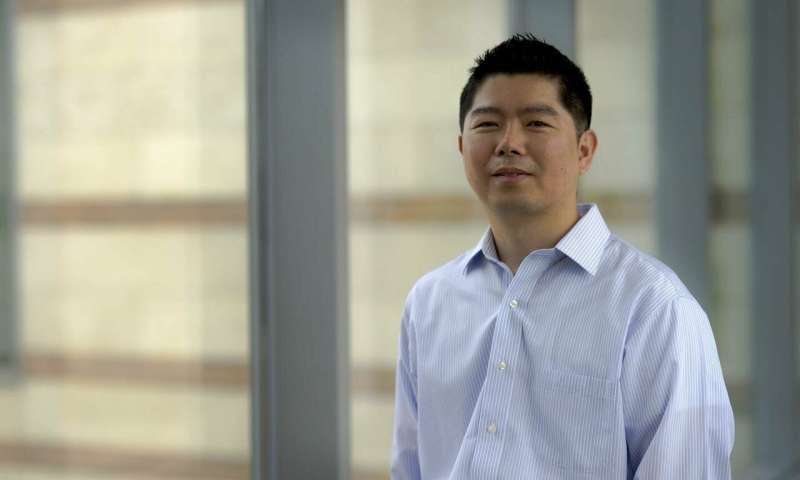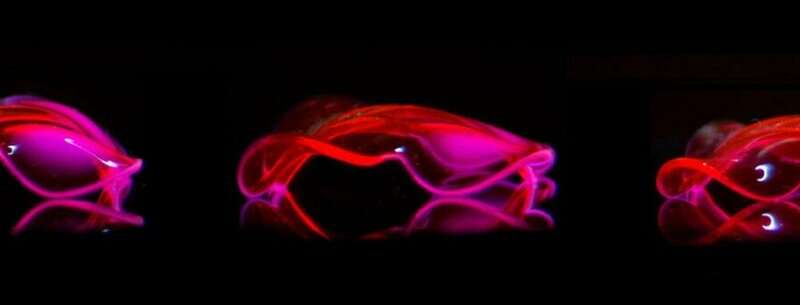UTA engineer earns NSF CAREER grant to develop bioinspired, shape-morphing 3D materials

A University of Texas at Arlington researcher is developing new technology to program 2-D materials so they can form complex 3-D shapes and motions.
Kyungsuk Yum, an assistant professor in the Materials Science and Engineering Department has been awarded a five-year, $500,000 National Science Foundation Early Career Development, or CAREER, Program grant to design and develop bioinspired 3-D materials with programmed shapes and motions.
The research could transform the way soft engineering systems or devices are designed and fabricated, with potential applications in bioinspired soft robotics, biomedical devices, tissue engineering and artificial muscles, which are soft materials that change their shapes or move in response to external signals as our muscles do.
Yum published groundbreaking research in Nature Communications on the topic in September, and he hopes to use this new award to expand upon and improve his current technology.
"Our discoveries so far have shown great promise, and I hope that we will be able to create materials that are capable of being programmed to perform much more complex movements," he said. "Previously, we focused on hydrogels, but now we will try to include biological cell components."
Yum's approach uses temperature-responsive hydrogels with locally programmable degrees and rates of swelling and shrinking. Those properties allow him to spatially program how the hydrogels swell or shrink in response to external signals—such as temperature change, electrical field and light—using a digital light 4-D printing method he developed that includes three dimensions plus time.

Using this method, he can print multiple 3-D structures simultaneously in a one-step process. He mathematically programs the structures' shrinking and swelling to form 3-D shapes—such as saddle shapes, wrinkles and cones—and their direction.
Yum also has developed design rules based on the concept of modularity to create even more complex structures, including bioinspired structures with programmed sequential motions. This makes the shapes dynamic so they can move through space. He also can control the speed at which the structures change shape and thus create complex, sequential motion, such as how a stingray swims in the ocean.
Yum's research is an example of data-driven discovery, one of the themes of UTA's Strategic Plan 2020: Bold Solutions | Global Impact, said Duane Dimos, the university's vice president for research.
"Dr. Yum's published research on this topic earlier this year showed that his work is innovative and transformative, and earning a CAREER Award is a feather in his cap. There is great potential in his research for making strides in biotechnology and robotics, and we look forward to seeing the results of his work," Dimos said.
The Faculty Early Career Development Program is the NSF's most prestigious award for junior faculty. Winners are outstanding researchers, but also are expected to be outstanding teachers through research, educational excellence and the integration of education and research at their home institutions.
Seven other UTA faculty have active NSF CAREER Award support:
- Jia Rao of the Computer Science and Engineering Department received $498,000 to redesign abstractions in virtualized systems to improve efficiency.
- Majie Fan of the Earth and Environmental Sciences Department received $485,627 in 2015 to enhance understanding of how the Rocky Mountains and how their modern, elevated landscape came to be.
- Matthew Walsh of the Biology Department received $600,000 in 2017 to study whether behavioral plasticity promotes or constrains adaptation.
- Yi Hong in the Bioengineering Department received $500,000 in 2016 to develop a polymer that will allow engineers to develop a scaffold that is flexible, conductive and biodegradable for biomedical applications such as tissue repair.
- Junzhou Huang of the Computer Science and Engineering Department received $545,763 in 2016 to discover a process by which image-omics data can be combined into files that are small enough that current computing technology will allow scientists to better predict how long a patient will live and how best to treat him or her.
- Ankur Jain in the Mechanical and Aerospace Engineering Department received $500,000 in 2016 to develop a fundamental understanding of how heat flows in materials within a Li-ion battery so they can be used safely in more applications.
- Alice Sun in the Electrical Engineering Department received $500,000 in 2016 to develop an all-liquid optofluidic laser that could better detect cancer in the comfort of a doctor's office.
Provided by University of Texas at Arlington